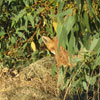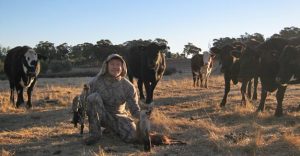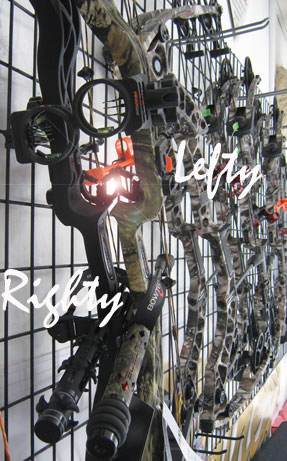
Bow tuning is all about getting your arrow flight dead straight shot after shot after shot. A bowhunters perspective on bow tuning is skewed somewhat – bowhunters square away their gear so both their practice arrows and BROADHEADED arrows fly straight and land on the same sight pins. If your hunting arrows don’t launch straight, your broadheads will plane or steer your arrows. This not only opens up your groups and changes your point of impact compared to your field tips – you lose out on penetration too. We owe it to the game we hunt to have our hunting arrows flying straight. Makes us better bowhunters too.
Before you can broadhead tune you first need to get your practice arrows flying like darts. Your field tips should not only be the same weight as your broadheads, but they should project out far like your broadheads do too. Click here…to see these Saunders points to see these Saunders points for a good example of this. Tuning MUST start with properly set up gear. This means all the obvious stuff is sorted – draw length, draw weight, accessories, D-loop, arrow rest and peep are all installed correctly. It is critical that your arrows are spined correctly. If you use quality arrows, their weight and spine tolerances will be very tight and your bow tuning sessions will be enjoyable and straight forward. If you use the cheapy Ebay or “Great Wall” ute type arrows – be realistic about your bow tuning expectations because the weight tolerances and more so, the individual spine on these arrows are all over the place. This means you’ll struggle to get tight broadhead groups landing on your sight pin.
Walk Back Tuning…
Paper testing is a very popular method of dialing in your ideal nocking point and arrow rest windagearrow rest windage sweet spot. But for bowhunters I suggest you master the Walk Back Tuning method because at long range I feel this testing method will give you better indicators to work to. I suspect paper tuning has its followers because, unlike the walk back method, it can be done in compact spaces like carports, in a pro shop etc.
Start with a 3 arrow field tip group at 20m (I’m assuming you’ve got your 20m pin sighted in and you are hitting what you aim at with this pin!). If you’ve got a touching arrow group – good. If not, it’s allen key time. First, let’s try shrinking the group by tweaking your nocking point location. You do this by moving your arrow rest up or down by one graduation at a time on your arrow rests adjustment marks. Move the rest down a click and shoot another group. Did you get a tighter group? If so, go down another graduation and shoot another group. If your first adjustment opened up the group – go the other way – move the rest up two clicks and test again. When you can’t shrink the group any more it’s time to mess with the arrow rest windage. This is the sideways adjustment of the rest. Like your nocking point adjustment, shoot 3 groups each time you move your rest in or out a graduation at a time. Experiment until you can’t shrink the group any more. Make sure you move your bow sight across with each windage change up too – so your pins continue to sit directly above your arrows. At this point, you know you’ve got your field tips doing a good job at 20m – the first half of the field tip tune is finished.
You’ll need to check your sight level check your sight level for each of the following shots. Shoot one field tip arrow into your spot at 20m, now walk back to 25m. Using your 20m pin, aim at your spot. Walk back to 30m and use your 20m pin for the 3rd shot. If your arrows are all in a vertical line – good. This means your arrows are being cast down the same line your eye sees through your peep and sight ring. It’s allen key time if your arrows migrate off the plumb line. If they land, say, to the left of your 20m shot, move your bow sight to the left a fraction of graduation and repeat the walk back test until your gold.
Before the broadhead tune starts, a word on your bow tuning so far. Right now your bow is tuned better than most. Period. Yes, you can do more than what you’ve done so far with bare shaft shooting, with vertical and horizontal line work and messing with the dynamic spine of your arrows with small poundage adjustments and so on. But with the quality zero nock travel bows and quality carbon arrows we shoot today I suspect you won’t feel the need to head down that route. And there is a trap to watch out for too – it starts with you thinking “If I can just get get my bow tuned that little bit more…”. Remember, a cheap and untuned bow with quality arrows will shoot touching arrow groups out of a shooting machine. They may be flapping their way down range to victory, but they’ll still hit the same spot. And you can only tune as good as your form allows.
Broadhead tuning is based on one key fact – the adjustments you make will migrate the broadhead group further than your field tip group. This means you will move your field tip group a bit in the broadhead tune phase, but the broadhead group will track over more and let you get both field tip and broadhead arrows landing on your pin. So now it’s time to shoot a two broadhead, one field tip group (in this order so you risk less arrow damage!) with your 20m pin at 20m. If all your arrows bunch up proper – good for you. Walk back to 40m or further and re-shoot the same arrow mix. Play with your dynamic spine with half limb bolt turns in or out and get the tightest group you can – with your long range arrows landing on the spot – it’s job done. Or… your broadhead group may land off to one side, maybe hit low or both, what-ever the case, it’s allen key time. Make fractional graduation adjustments of the arrow rest for windage first. This often improves your broadhead height postion too. When you’ve got you broadheads landing in line with the field tips you’re only one nocking point adjustment away (from correcting low or high BH impacts).
If your two arrow broadhead arrows don’t group as tight as your field tips do you – double check your broadhead group size with a 3 arrow group. If it’s larger than your field tip group you need to find out why. Remember, broadheads magnify any hunting rig flaw – way more than field tips do. Here’s a checklist to find out why your broadhead groups aren’t up to muster…
* Broadheads MUST weigh the same as your field points.
* Helical fletch with stiff short style vanes; eg- Bohning Blazers, Fusions or Raptors. You may get better flight with 4in vanes fletched helical.
* Test for arrow rest/fletch contact with lipstick on the arrow rest launcher.
* Re-set nock height so the arrow sits square to the string – zero nock travel – all the best bow manufactures make zero nock travel bows.
* Know your bows IBO speed at your poundage – beyond 270fps most 2-blades broadheads start to fly their own path – get good advice on the right broadhead for you.
Nock tightness – with a two finger tap and your arrow must fall off the string.
* D-loop must be as short, tied in the ‘balanced’ style and not crowd the nock.
* Make sure your broadheads all line up the same way.
* Centre shot adjustment – your arrow must sit square to the string with the pins also in line. Try adjusting poundage in/out with 1/2 turns to get your arrow hitting on the pin head at 20m. Still struggling? Your arrow spine is too weak. Change to 100gr field tips and re-sight, re-tune as before. Lighter field tips/broadheads will have the effect of stiffening your arrows. If you still struggle with open broadhead groups you must move up to stiffer spined arrows.
Keep at it, you’ll get there. And when you do, in the words of Babe… “That’ll do Pig, that’ll do”.





